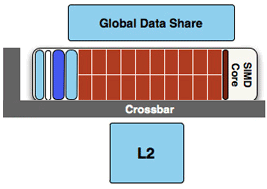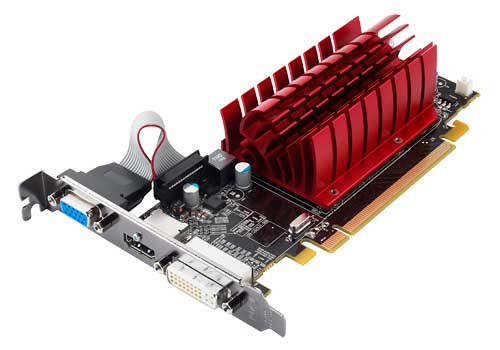AMD’s Radeon HD 5450: The Next Step In HTPC Video Cards
by Ryan Smith on February 4, 2010 12:00 AM EST- Posted in
- GPUs
4 chips in 6 months reaches its end today, with the launch of the final chip in AMD’s Evergreen stack: Cedar. Cedar, the baby of the family, will be powering AMD’s bottom-tier cards. Today we’re seeing the the first of what we expect will be a couple of Cedar cards with the launch of the Radeon 5450.
| AMD Radeon HD 5670 | AMD Radeon HD 4670 | AMD Radeon HD 5450 | AMD Radeon HD 4550 | |
| Stream Processors | 400 | 320 | 80 | 80 |
| Texture Units | 20 | 32 | 8 | 8 |
| ROPs | 8 | 8 | 4 | 4 |
| Core Clock | 775MHz | 750MHz | 650MHz | 600MHz |
| Memory Clock | 1000MHz (4000MHz data rate) GDDR5 | 1000MHz (2000MHz data rate) GDDR3 | 800MHz (1600MHz data rate) DDR3 | 800MHz (1600MHz data rate) DDR3 |
| Memory Bus Width | 128-bit | 128-bit | 64-bit | 64-bit |
| Frame Buffer | 1GB / 512MB | 1GB / 512MB | 1GB / 512MB | 1GB / 512MB |
| Transistor Count | 627M | 514M | 292M | 242M |
| TDP | 61W | 59W | 19.1W | 25W |
| Manufacturing Process | TSMC 40nm | TSMC 55nm | TSMC 40nm | TSMC 55nm |
| Price Point | $99 / $119 | $60-$90 | $49-$59 | $35-$55 |
It should come as little-to-no surprise that Cedar and the Radeon 5450 finally deviate from the rule-of-2 that has marked the difference between the other Evergreen family members. Whereas all of the larger Evergreen chips have effectively been ½ of their bigger sibling, Cedar cuts right to the bone. It’s half as many ROPs as the Redwood-powered Radeon 5670, but 40% of the texturing capacity, and a mere 20% of the shader capacity. As has always been the case for video cards, once you drop below $100 you have to start sacrificing a lot of hardware to meet lower price targets, and Cedar is no different.
For throwing all of those functional units out along with GDDR5 capabilities, Cedar comes in at a slender 292M transistors with a die size of 59mm2. This is a little less than half the transistor count of Redwood while being a little more than half the die size. In this case the limited reduction in transistor count in spite of the significant reduction in shader capabilities is an excellent example in what makes cutting a design down to budget-levels such a tricky proposition. AMD won’t release a die shot of Cedar (or anything else of Evergreen for that matter) but it’s a safe assumption that most of Cedar is occupied by fixed and semi-fixed units such as the PCIe controller, UVD2.2, and AMD’s fixed function rendering pipeline. AMD can’t scale down any of these units like they can shaders, hence shaders had to take the brunt of the cuts to get a sub-300M transistor chip.

Attached to Cedar is a 64bit memory bus, which as we stated before drops GDDR5 memory support. Instead Cedar will be paired with DDR2 and DDR3 – with today’s launch card being a DDR3 variant clocked at 800MHz. This also makes the 5450 the first card to launch with something other than GDDR5, which has otherwise been paired with everything from the 5970 to the 5670.
Compared to the RV710 chip at the core of the Radeon 4350 and 4550, Cedar and the 5450 are virtually identical to those parts. It has the same number of functional units and the same memory interface running at the same speeds, making it the closest thing yet to a 4000-series card with DX11 + Eyefinity functionality. Cedar is even pin-compatible with RV710, so that manufacturers can drop it in to existing Radeon 4350/4550 designs. And just to put things in perspective, in spite of these similarities Cedar is 50M transistors larger than RV710, which means AMD spent most of their gains from moving to the 40nm process on adding Evergreen family features and getting a slightly smaller chip. This also means that it’s a safe bet that we’ll see AMD double-up on functional units for the next die shrink.

One of the advantages of throwing out so much shader hardware and dropping GDDR5 is that the power usage of the card comes down significantly, playing well in to the low-power nature of budget video cards. AMD specs the 5450 at a mere 19.1W TDP, and an idle power usage of 6.4W. This is more than 2/3rds lower than the 5670. Lower clockspeeds also play a part here, as the 5450 is the lowest clocked 5000-series card yet, at a core clock of 650MHz.
It goes without saying that as a budget card AMD is not targeting hardcore gamers with the 5450, instead the target market is a mix of buyers who need their first real GPU on a tight budget. This means pushing the Radeon 5450’s UVD/HTPC capabilities, Eyefinity, GPGPU acceleration, and it’s significantly improved gaming performance over IGP solutions. AMD is making sure to tag the 5450 as a DX11 card too, but as we’ve already established from our 5670 review, cards this slow are too slow to take advantage of any of DX11’s wonder features – the tessellator is probably going to be the only DX11 feature to see any action on cards of this performance level.
AMD is framing the 5450 as competition for NVIDIA’s bottom-tier GeForce, the GeForce 210. From a power and form factor standpoint this is a good matchup, however the 210 uses an even smaller GPU than Cedar along with DDR2 memory, which means there’s certainly a performance difference but also a pricing difference, since NVIDIA should be able to build the 210 for less. Pricing-wise the 5450 is in competition with the DDR2 GeForce GT 220, the Radeon 4550, and the Radeon 4650, all of which can be found for around the same price if not lower in the case of the 4550.










77 Comments
View All Comments
Taft12 - Thursday, February 4, 2010 - link
Replying to my own post to say I reread the 5670 article and indeed the 5500 series is mentioned there and I am VERY sure this is what Ryan was referring to earlier when he said "wait a week"juampavalverde - Thursday, February 4, 2010 - link
I dont see the improvement over the past generation 4550. DX11 is useless in such slow cards (is almost useless for a 5670!). I expect this level of performance from a next gen IGP, not a discrete chip. AMD should have raised high the performance bar for this generation, releasing something like 5450 (120 sp), 5670 (640 sp, like 4770), 5770 (960 sp), and 80 sp for the IGP.Taft12 - Thursday, February 4, 2010 - link
The improvement is purely in power consumption. They can't improve performance of these lowest-end discrete cards or IGPs too much or they will eat into the value of the next step up (4670, 5670). You may "expect this level of performance" but you aren't gonna get it.Rick83 - Thursday, February 4, 2010 - link
I'd be rather interested in seeing a differentail analysis of power consumption of the two ATI cards (5450/5670) at rendering a h264 encoded 1080p movie with dts out via the card, as well as blu-ray with "HD".And a video benchmark, to show how much bitrate/fps the respective cards manage, before desync/framedrop/freeze.
Power during furmark (or gaming) is of course higher on the 5670, because it has five times as many shaders to feed - depending on how smart ATI's power management is, the two cards might not differ a lot, if used in an HTPC.
And frankly, the 50 dollars extra would be probably worth the extra rendering/decoding horsepower, especially in an HTPC, where you want buttery smooth performance, and not worry about bitrate.
Oh - any news on passive 5670's? If they can do 5750's, I'm sure there'll be a few 5670's someday?
Ryan Smith - Thursday, February 4, 2010 - link
This isn't something we tested since it really isn't an issue. The Cheese Slices test peaks at 35MBps MPEG-2, and I have an H.264 version that peaks at a similar bitrate.The 5450 has enough power for anything up to 1080p Blu-Ray.
Rick83 - Thursday, February 4, 2010 - link
Well, considering the extra shader load added by filters, apparently it may not be - or the proper algorithm for deinterlacing would have been available.And that also leaves the question of the power draw of a 5670 at 5450 levels of performance - I'm pretty sure that in an HTPC, unless you use it as a console replacement for gaming, there will ever be a situation where the gpu is fully loaded, hence power input should be lower than the full-tilt number you published.
dagamer34 - Thursday, February 4, 2010 - link
Most HTPCs are meant to be small, and there's no way you're going to be able to fit a 5700 series card into a low-profile space. I know they had 4650s last generation, but there aren't any 5650s yet. =/Redstorm - Thursday, February 4, 2010 - link
I just cant see how reviewers are claiming this card is the perfect HTPC video card. Not everyone uses Microsofts Media Centre. Lack of VDPAU support for Linux is a glaring hole in all ATI cards, If I were building a gameing PC today I would probably buy an ATI 5870, But if your building a low power HTPC you cant go past nVidia and VDPAU support. Take their ION platform will do 1080p in hardware on Linux for less than 30Watts this beats this ATI offering hands down when you add in Motherboard and CPU.Best HTPC card I think not...
CiNcH - Thursday, February 4, 2010 - link
XvBA is also said to be working, which also acts as a backend to VA-API, just like VDPAU. They are even examinig the legal situation and whether the UVD specs can be opened to be support within the OSS (xf86-video-ati) driver. Of course nothing that will be done by tomorrow.What I think would be worth mentioning, when it comes to HTPC comparing nVIDIA and ATi, is that UVD won't play H.264 higher than level 4.1. nVIDIA's PureVideo is capable of decoding up to level 5.1.
milli - Thursday, February 4, 2010 - link
The Evergreen series does apply angle independent anisotropic filtering. Also the fixed function interpolators have been removed and moved to the shaders.Considering the limited power of the HD 5450, this causes a bigger performance drop compared to the other Evergreen products.